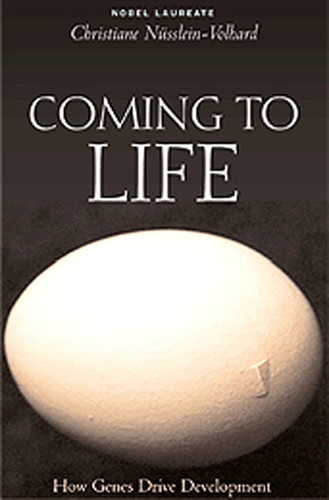From Genes to Embryo and Beyond
INTRODUCTION
The study of embryology goes back to the nineteenth century when Karl Ernst von Baer recognized that there are similarities between embryos of different species and that those similarities disappear as the embryos mature into adults. This notion was later observed and studied by Charles Darwin, who established the idea of a common ancestor to explain embryological similarities. Developmental biology has been growing exponentially as a field since the 1970s when biochemical techniques and later on molecular techniques allowed most of the studies that have defined the field to its current status. Nobel Laureate Christiane Nüsslein-Volhard, who pioneered along with Eric Wieschaus the discovery of genes that guide development in the fruit fly Drosophila, has taken on the gigantic task of writing a historical and sociopolitical account of developmental biology primarily for a lay audience. No one is more qualified than Nüsslein-Volhard because she has carried out pioneering developmental genetics work in invertebrates and more recently in the vertebrate zebrafish (Danio rerio) and currently directs the Max Planck Institute for Developmental Biology in Tübingen, Germany.
Coming to Life, with a main text of 145 pages, addresses in 10 chapters major highlights that have shaped the field of developmental biology and how current scientific and social issues can be understood and perhaps adequately addressed in light of a more accurate understanding of embryonic development. The first nine chapters take the reader to various milestones in genetics, development, and biology in general. Each one of these nine chapters includes hand-drawn figures, which give a personal touch to the narrative and perhaps makes the content less intimidating to the layperson. The last chapter, “Current Topics,” is the author's personal manifesto of how to use understanding of development to be well-educated consumers of science and some of the issues that emerge from misuses and misunderstandings of scientific information.
DISCUSSION
The first chapter, “Origin and Heredity,” discusses the work of Carl Linnaeus, Charles Darwin, and Gregor Mendel and how they laid the groundwork for our current understanding of biology. I found her use of the terms hypothesis and theory somewhat inconsistent by being used interchangeably. This is just a minor criticism and by no means alters the quality of the author's accomplishment in presenting a concise journey of major experimental ideas of the nineteenth century.
Additional chapters address classical experiments, such as those performed by Theodor Boveri transplanting the nuclei of sea urchins to show the importance of the nucleus as a carrier of genetic information. The simplicity of the author's drawings lends a sense of familiarity to elegant experiments such as those carried out by Hans Spemann in his quest for a so-called morphogen responsible for causing cells to adopt specific fates, thus giving rise to different structures in the developing embryo.
Nüsslein-Volhard never loses perspective when trying to convince the reader that development is a function of genes. On pages 52–55 she makes a simple argument regarding the logic of genes driving development by illustrating the identification of those genes responsible for anterior-posterior segmentation in the fruit fly. Most textbooks make a similar attempt using many more pages. Once body patterning is discussed in later chapters, the author takes an evolutionary approach by discussing how innovations in the body plans of organisms have allowed these to adapt to new conditions. By doing so, readers are left with an overall synthesis of how development is the result of the interaction of genes and the environment.
The last chapter takes a significant departure when the author shifts her approach to discuss personal ideas regarding sensitive issues such as human reproduction, gene therapy, and stem cell research. The question of what constitutes a human embryo is posed and the reader is left to make her/his own decision. She cautions the reader to inspect information more closely to make informed decisions when the society as a whole is engaged in debate. She concludes by saying: “The most important factor, however, is to proceed with care and ensure that possible contributions of medical research to reduce pain and suffering are not prohibited for fear of misuse” (p. 145).
Coming to Life accomplishes its mission “to give a brief and concise overview” (p. xii). The book is appropriate for anyone with some general background in biology, including advanced high school students. High school teachers can benefit by incorporating some of the simplicity presented by Nüsslein-Volhard when explaining difficult concepts such as cell signaling. In terms of my own teaching (undergraduate nonmajors), any of the chapters can be assigned without any doubt that students would be able to follow the author's thesis of “understand[ing] the processes of life a little better without having to deal with highly specialized knowledge” (p. xii). The book includes a brief glossary that explains some technical terms. A significant omission of the book is any work on plant development, which is too bad given the prominent role of Arabidopsis in understanding molecular aspects of development.
All in all, Coming to Life is a much-needed primer of developmental biology. As biological information becomes more complex and the significance of developmental genetics makes its way into national education standards and the science news, a basic understanding of development may become a necessity for those wishing to be educated citizens in current scientific issues and related debates. A field that has made great leaps over the past 40 years deserves more recognition by stakeholders in the economic, legal, and political arena—and the author has not shied away from making her case. Christiane Nüsslein-Volhard has taken a major step to convey the essence of embryonic development as a crucial piece in understanding biology and the nature of science.

Figure 1. Coming to Life.



